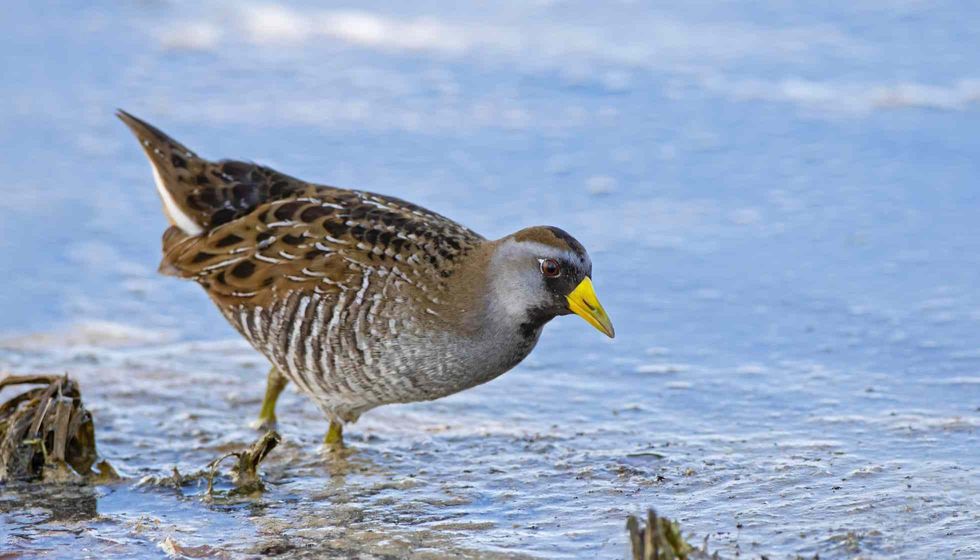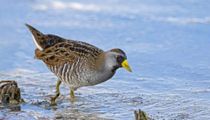The sora bird, also known as sora rails and sora crake is a small migratory waterbird. They inhabit the marshes of North America such as central California, New Mexico, and Arizona.
They belong to the Rallidae family which is a family of ground-living birds. They come under the class Aves and order Gruiformes.
Sora Porzana Carolina is usually found in the marshes, or wetlands where they can easily hunt for small insects, seeds, and snails. They are one of the most common rails in North America that come under order Gruiformes.
They are migratory birds and their migration range is from the northern parts of North America during the summer months to the southern parts in the winter and fall time. They also migrate to certain parts of South America and Central America during the winter and fall months.
If you want to know more such interesting facts about sora birds, then keep reading.
For more relatable content, check out these king rail facts and Guam rail facts for kids.
Sora Interesting Facts
What type of animal is a sora?
Sora is a small-sized bird from the Rallidae family. They belong to order Gruiformes and are one of the most common rails in America.
What class of animal does a sora belong to?
Sora Porzana carolina bird belongs to the class Aves.
How many soras are there in the world?
There is no defined number of Sora birds but their population is stable and they are very commonly found in North America but their migration also takes them to the South and Central parts of America.
Where does a sora live?
Sora lives in various places throughout the year due to their migration activities. They spend the breeding season in Alaska, Northwestern California, New Mexico, and other Southern parts of the American continent.
In the winter season, they can be seen in central California And other places across Central America to South America. They can also be seen in shallow waters hidden near marshes near west New York making their nest in between talk plants. Although it is very difficult to spot them in New York City.
What is a sora bird's habitat?
The main sora habitat is brackish wetlands, freshwater bodies, rushes, wet pastures, and flooded fields with dense vegetation. For nesting, they choose a shallow wetland edge surface of dense vegetation sedges and cattails. They use cattails to build their nest and hence during the breeding season, their usual habitat is near such vegetative grounds.
Who do soras live with?
Soras live with others of their species. They are rarely seen alone in their habitat and especially during the breeding season, soras live in pairs to take care of their nest as well as the eggs.
How long does a sora live?
There is no proven information on the lifespan or survival of the sora species.
How do they reproduce?
The sora bird reproduces sexually. Both the male and female sora execute courtship during the breeding season where they preen and bow to each other.
They make nest with cattails, bulrushes, and sedges along the shallow wetlands on top of the grass or dense vegetation. These birds nest on the ground in between tall plants where they can be hidden from potential predators. Both the male and female are responsible for the incubation of the sora eggs.
The egg hatching takes 18-20 days. After hatching from the eggs, the young are fed by both male and female soras and they can start flying within 20-25 days.
What is their conservation status?
It is legal in various states of America to hunt soras but their population has not declined. Also, soras migration occurs during the night, and hence a lot of deaths due to collisions with lighted towers during the flight are reported. However, even after all the difficulties, the conservation status of sora is 'Least Concern’.
Sora Fun Facts
What do soras look like?

Sora is a small-sized bird that grows no more than 8-10 in (20-25 cm). They have a wingspan of 12 in (30 cm) during flight. One of the main characteristics of soras is their yellow bill.
They have brown feathers on their body with white edges. They have a black mask covering half of their face and a white throat and underside. They also have some mottled grey feathers. Soras have light green legs.
The females of the species are seen to be less colored in comparison to males. Unlike males, the black of their face is lesser. The young also do not have a black mask on their face and look more like the females.
How cute are they?
In terms of cuteness, the brown-colored Sora bird is not very cute. Their bodies do not have a lot of colors and their yellow bill and white throat also make them a little scary which can not be considered cute.
How do they communicate?
They often communicate through body language, especially during the breeding season. Apart from this they also make sharp calls and whinny noises to communicate with each other.
The descending whinny notes are sometimes also used to make distress calls. They also make some piping notes. Both males and females can be seen making these whinny calls normally as well as during the breeding seasons.
How big is a sora?
Sora comes under the category of small to medium-sized birds. They are three times the size of a song sparrow but they are smaller than a Virginian Rail or a brewer blackbird. They can be compared to the size of a robin bird.
How fast can a sora bird fly?
There is no documented information regarding how fast the sora is during flight.
How much does a sora weigh?
Sora rails are lightweight birds and most of their weight comes from their feathers. The adult sora bird will weigh in the range of 1.72 - 3.95 oz (49 - 112 g). This weight is the same for both males and females.
What are the male and female names of the species?
The males and females are called sora only. There is no specific name given to males and females.
What would you call a baby sora?
There is no specific name given to baby sora. They are called juvenile or young just of the eggs.
What do they eat?
Sora diet includes seeds from vegetation in wetland, small aquatic insects, and snails. They also sometimes eat plants.
Are they friendly?
Soras are very shy and secretive in nature. They are not a friendly bird species. Their secretive nature makes it very difficult to spot them.
Soras can get alerted by a small call or a small noise. Their habitats are also in hidden areas in between marshes where most people do not visit. Hence they can not be considered very friendly.
Would they make a good pet?
No, soras are wild birds and very secretive in nature. Hence, they do not make good pets. They can not be trained.
Did you know...
Sora birds can often get startled with the slightest of noises and run at lightning speed to hideaway. Even though they are one of the most commonly found Rails in North and South America, spotting them is very difficult because of their shy nature.
What does a sora sound like?
Sora bird call is whiny, especially when they are alerting danger. They also make piping noises to communicate with each other. They are high-pitched and can be often heard during the nights.
What are the other names for the sora bird?
Sora rail and sora crake are two other names for the sora bird.
Here at Kidadl, we have carefully created lots of interesting family-friendly animal facts for everyone to discover! For more relatable content, check out these Virginia rail facts and strawberry finch facts pages.
You can even occupy yourself at home by coloring in one of our Sora (Bird) coloring pages.









